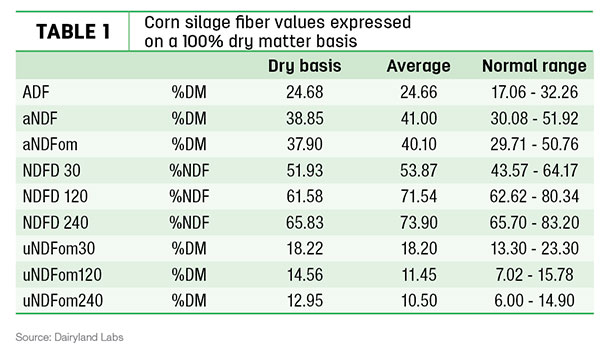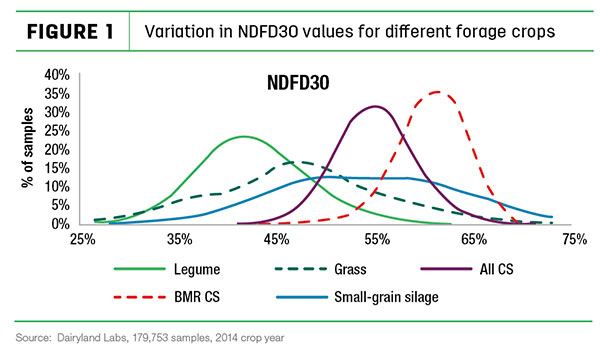Fiber continues to be a key nutrient in the dairy rations of high-producing cows. Forages are the main source of fiber that may be raised on the dairy farm. But quality can vary greatly from crop to crop and year to year.
Forage fiber is important to maintain rumen function and health, control rate of feed passage, provide a nutrient source for rumen microbes, result in cud chewing and production of buffers in the saliva, and maintain optimal milk components. New research results and forage testing lab tests have allowed us to fine-tune forage fiber.
The basic forage terms and applications are outlined below using corn silage values in Table 1 for examples.
Forage Fiber 101 – going to class
The following forage fiber terms may be found on ration-balancing programs and forage test results. Each fiber value can impact your feeding program and improve correct decisions.
ADF (acid detergent fiber) consists of cellulose and lignin. It is related to forage digestibility and was used earlier to estimate energy values of forage. ADF is not commonly used by some nutritionists. My guideline is 18 to 21 percent in the total ration dry matter as a tool to evaluate forage quality in the ration. Over 21 percent ADF may limit energy levels and feed intake.
aNDF is a newer term replacing NDF (neutral detergent fiber), as the forage NDF level is corrected by removing starch by an enzyme treatment (amylase, which results in the aNDF terminology).
aNDFom is a refinement of the aNDF, removing ash (mineral) associated with the aNDF level. In Table 1, this difference in the example corn silage was less than 1 percent. The “om” refers to organic matter or ash-free. Our recommendation for aNDF or aNDFom is 28 to 32 percent of the total ration dry matter.
Lower levels of NDF can lead to below-optimal rumen fermentation while high values can limit feed intake. (ADF, aNDF and aNDFom are expressed as a percent of the ration dry matter by this lab.)
Lignin is another fiber value (not listed in Table 1) which has little to no digestibility. Higher lignin levels can limit feed intake and reduce energy in the ration. We suggest total ration lignin levels between 3 to 4 percent of the ration dry matter. Adding processed straw can be considered when lignin levels are low.
NDFD30 (neutral detergent fiber digestibility at 30 hours) represents the digestibility of the NDF after 30 hours of fermentation in the digestive tract.
Another term is NDFD48, which is analyzed at 48 hours in the digestive tract. Researchers report NDFD48 is more accurate to measure with less variation, while NDFD30 represents the typical residence of feed in the digestive tract.
NDFD120 and NDFD240 represent the digestibility of NDF with longer exposure times in the digestive tract. Researchers can take these longer time values and model the rate of NDFD over time to predict cow performance, nutrient availability and intake values. (NDFD values are expressed on a percent of NDF in the forage or feed by this lab.)
uNDFom30 represents the portion of NDF not digested in the 30 hours in the digestive track. Forage quality and type are key considerations. High values can risk limiting feed intake and milk yield.
uNDFom120 and uNDF240 extend the time period forages are exposed to digestive processes. Researchers recognize forage fibers do not remain in the digestive tract for five to 10 days, but reflect the dynamics of the degradation process, which can be modeled in ration-balancing programs. (These values of uNDF30, uNDD120 and aNDF0m240 are expressed as a percent of the dry matter by this lab.)
Great – but what does it mean?
Look at the variation or range in Table 1; corn silage is not corn silage. Table 1 lists the sample corn silage under “dry matter basis,” the average values received in the lab and the ranges in values. This data drives home the need to conduct timely forage test results.
Pick the forage fiber values you want to focus on. My biases are:
- Use aNDFom or similar NDF value to evaluate forage quality and its impact in the ration.
- NDF30 is used to evaluate forage quality within each type of forage (corn silage over 55 percent, legume/grass forages over 50 percent, for example). Select your target levels when selecting forages for high-producing cows, dry cows, heifers and low-producing cow rations.
- uNDFom30 is used to estimate potential intake in the ration. Our guideline is 6 to 6.2 pounds for Holstein cows in the total ration dry matter. If you select uNDFom240 for dry matter intake, one guideline is 0.3 percent of a cow’s bodyweight.
For example, a 1,400-pound cow could consume 4.2 pounds in the total ration. Ration software will be able to calculate this ration value, allowing you to compare it when different forages and byproducts are fed.
- ADF and lignin are used when reviewing forage and total ration fiber values. These two values give me a quick impression of fiber quality (it may be an old habit too).
- The missing fiber value is effective, cud-stimulating, physically effective NDF (or peNDF). The values listed above are chemically analyzed fiber. I use the Penn State Particle Separator box for this value. Some labs can analyze for this value using a screening device.
The use of NDFD and uNDF results can assist in selecting hybrids to plan for next year and ranking forage quality on the dairy farm (Figure 1). Use the same lab with analyzing NDFD values, as feed preparation of forage and TMR samples can vary from lab to lab.
Evaluating the corn silage example – good and bad news
The example corn silage in Table 1 would receive an average grade from me. ADF and aNDFom values are below average values (good news reflecting less fiber) and higher potential levels of starch. The NDF30 values are below average (bad news), which mean the fiber is lower quality, resulting in less energy.
The uNDF values from 30 to 120 to 240 hours are slow (bad news), which may indicate slower degradation, limiting dry matter intake and thus producing less milk.
My summary is that the level of fiber is optimal, but the quality of the fiber is below optimal (which could be due to the growing season, stage of maturity, hybrid or other management factors). ![]()

-
Mike Hutjens
- Professor of Animal Sciences Emeritus
- University of Illinois – Urbana
- Email Mike Hutjens






